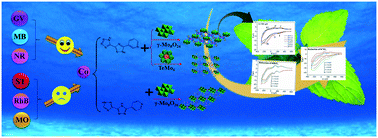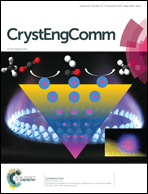Novel polyoxometalate-based cobalt complexes based on rigid pyridyl-triazole-tetrazole and pyridyl-bis(triazole) ligands†
Abstract
Three novel polyoxometalate (POM)-based metal–organic complexes (MOCs) constructed from rigid pyridyl-triazole-tetrazole and pyridyl-bis(triazole) ligands have been hydrothermally synthesized and structurally characterized: [Co3(Htyptz)2(γ-Mo8O26)(H2O)6]·4H2O (1), H2[Co3(Htyptz)2(TeMo6O24)(H2O)8]·6H2O (2), [Co3(Hpyttz)2(γ-Mo8O26)(H2O)8]·2H2O (3) (H2typtz = 3-(tetrazol-5-yl)-5-(pyrid-3-yl)-1,2,4-triazolyl, H2pyttz = 3-(pyrid-4-yl)-5-(1H-1,2,4-triazol-3-yl)-1,2,4-triazolyl). Single-crystal X-ray diffraction analyses reveal that complex 1 is a 3D metal–organic framework. Both 2 and 3 are 2D metal–organic architectures. In complex 1, the adjacent [γ-Mo8O26]4− anions are linked by the CoII ions to form a 1D Co-γ-Mo8O26 inorganic chain. Then the 1D Co-γ-Mo8O26 inorganic chains are linked together by the 1D metal–organic Co-Htyptz chains to form a 3D framework. In complex 2, the adjacent Co-Htyptz metal–organic chains are connected by TeMo6 polyoxoanions to form a 2D architecture. In complex 3, [γ-Mo8O26]4− anions are bridged by the CoII ions to give similar 1D Co-γ-Mo8O26 inorganic chains to those in 1, which are connected through [Co(Hpyttz)2] units to form a 2D network. 1 and 2 represent the first examples of POM-based MOCs derived from H2typtz. The effects of the POM type and different ligands on the structures of the title complexes were discussed. The adsorption activities for organic dyes methylene blue (MB), gentian violet (GV), methyl orange (MO), rhodamine B (RhB), neutral red (NR) and safranin T (ST) have been investigated in detail. Furthermore, the electrochemical properties of 1 and 2 have been studied, which display electrocatalytic activities toward the reduction of nitrite and bromate. 1-CPE shows pH-dependent electrochemical behaviors and may be used as a potential sensor.



 Please wait while we load your content...
Please wait while we load your content...